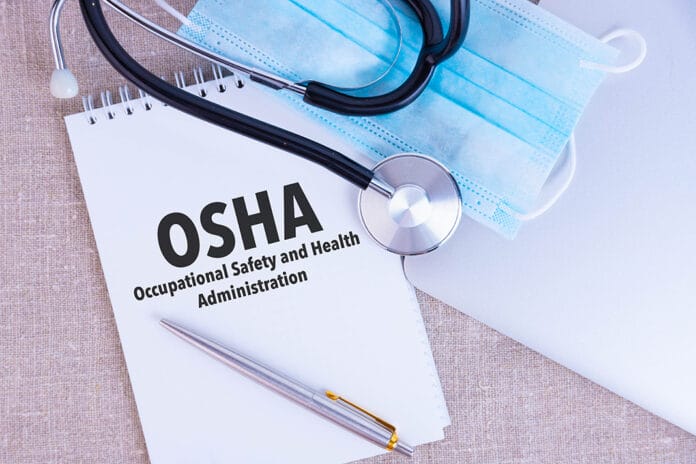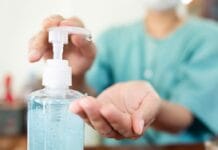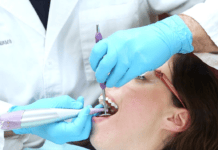Prior to the pandemic, during a normal hectic workday at my office, the local component of the Occupational Safety and Health Administration (OSHA) dropped in for a surprise visit. I think it is safe to say that this is one of the most dreaded moments by dental professionals in a dental office. While many offices go their entire business life without a visit from this organization, some are unpleasantly surprised with an impromptu visit from OSHA.
While my office practices OSHA compliance, we were sure that he could find something wrong with our efforts. If you could have seen us scrambling to make sure everyone was “dotting their I’s and crossing their T’s,” you would have been highly entertained. Thankfully, this gentleman was simply approaching dental offices to offer a free walk-through service in an attempt to help offices ensure compliance.
As the OSHA representative in our office, I decided that it was in our best interest to sign up for the service he offered that day during his unannounced visit. We scheduled a later date for him to return to inspect our office for any violations that we would be able to correct without any fines or citations. COVID-19 spared us much time during the shutdown to comb through our office like a dental hygienist performing an SRP. In addition to the walk-through, it’s safe to say I learned much about compliance and felt just maybe you too could use some helpful tips in case OSHA shows up uninvited on your doorstep.
Who Are These People Anyway?
The Occupational Safety and Health Administration (OSHA) is part of the United States Department of Labor. The agency was devised to assist in safe and healthful working conditions for workers by setting and enforcing standards and providing training, outreach, education, and assistance.1
All of these regulations can be found in a manual that could be considered the Bible of the workplace environment, and its formal title is Title 29 of the Code of Federal Regulations (CFR). This very large manual can be exhausting to read and, unfortunately, is not an interesting read that drags on in suspense and ends with a twist. While much of the information is relatively common knowledge, it is easily assumed that the office is safe and compliant while many violations are unknowingly occurring. From October 2019 to September 2020, OSHA handed out $111,750 in penalties to dental offices alone among 20 inspections.5 Of those penalties, bloodborne pathogen transgressions accounted for $63,624.5
A Few OSHA Highlights to Note
Written Exposure Control Plan: Every office must complete and maintain this detailed manual that includes the Bloodborne Pathogen Standard. OSHA provides a template on their site that can be modified to fit individual offices. Each employee must be familiar with this manual and know where it is located in the office. As the saying goes, “failure to plan is planning to fail.”
One employee should be a dedicated OSHA coordinator and supervise the compliance with OSHA standards. This designated individual should have a vast knowledge of infection control and be responsible enough to coordinate annual training and implement policy and procedures. While this is a BIG role to take on, it does not increase liability for violations for the individual as that would still ultimately fall on the owner of the practice.
The coordinator would be the responsible individual for compiling a written exposure plan. On May 2, 2018, OSHA cited a Connecticut dental facility for failure to establish a written exposure plan and fined $2,772.6
The Bloodborne Pathogen Standard: This standard is designed to help protect workers that are exposed to blood and other potentially hazardous materials (saliva, for example).4 Employees must gather annually and complete training on this standard. This plan includes proper personal protective equipment (PPE), hepatitis B vaccinations, housekeeping, regulated wastes, and work practice controls.
While most of this seems like common sense, it must all be documented and followed according to OSHA standards and guidelines. I can promise you they are different from your own. This is the most often OSHA-cited standard for dental facilities.6
Hepatitis B vaccinations: This vaccination should be a requirement among dental professionals considering the high rate of potential exposure. While OSHA does not mandate the vaccine, it does, however, require proof of either the vaccine or declination for each employee. Employers are required by OSHA to offer the hepatitis B vaccine to each employee should they need the vaccine. If employees have already received the vaccine prior to hiring or simply decline to receive this vaccine then an on-site declination form is required by OSHA.
Injury and Illness Incident Report (OSHA Form 300): Every dental office must maintain an injury incident log yearly, even if no incidents have occurred. This documentation is something OSHA will definitely request to see. This log and summary must be kept on file for a period of five years.6
Instrument processing: OHSA 1910.1030(d)(2)(xiii) states specimens of blood or other potentially infectious materials shall be placed in a container that prevents leakage during collection, handling, processing, storage, transport, or shipping.7 Ensure that instruments are not carried from the treatment room to the sterilization room without a locking tray lid. We all hustle like a cat on a mouse between patient appointments to either scarf down our snack, take a potty break, or prevent falling behind schedule. This standard prevents sharp injury should two people collide in transition.
Use of disinfectants: Know the disinfectant times for any and all disinfectants used in the office. This is pretty easy if you use the same brand and type of disinfectant. However, amidst COVID-19 dental offices were happily accepting any disinfectant in stock. At one time, our office was littered with at least five variations. I learned a quick trick for this situation: writing the kill time on each container in a permanent marker.
Regulated waste: A sharps container must be present in every treatment room, and the person who loads the dental syringe must also be the one who dissembles. I know, I know, this seems self-explanatory but apparently is still not being followed in many offices. Use biohazard stickers where necessary and dedicate bins for solid biohazard waste (soaking bloody gauze). Biohazard labels must also be on the ultrasonic, autoclave, and any lab cases. Not only did we use red biohazard bags in our hazardous waste bins, but we slapped a biohazard sticker on the outside of the can. Leave no doubt!
Documentation
Safety data sheets (SDS): These are formally known as MSDS sheets and were restructured in 2012. The modifications to the standard include revised criteria for the classification of chemical hazards; revised labeling provisions that include requirements for the use of standardized signal words, pictograms, hazard and precautionary statements; related revisions to definitions of terms used in the standard, and requirements for employee training on labels and safety data sheets.2
This rule went into effect in 2012; therefore, employers should not maintain any SDS sheet older than this date. But also check SDS sheets frequently for the most updated version. An electronic database may be maintained only if the file is accessible to all employees. It is recommended to place the file on a cloud drive. Remember to obtain SDS sheets for oxygen and nitrous oxide, and a little word from experience: Know the pictograms because they will most likely quiz you! In the dental office, the pictogram for irritants (an exclamation point) is fairly common as many of the materials can be irritating in an accidental exposure. In 2020, failure to comply with the Hazard Communication Standard was listed as one of the top 10 OSHA violations.3
Respiratory Standard – because COVID-19
Respiratory Standard 1910.134: COVID19 entered a new dynamic into dental offices regarding the OSHA respiratory standard. With more professionals gearing up with N95, KN95, N100, or actual respirators, OSHA requires a written respiratory program if these masks are required by the employer.8 If mask selection is optional, then the employees who choose to wear these forms of masks must be given Appendix D from this standard. This appendix informs the employee of precautions when wearing a respirator that the respirator itself does not cause harm.
While this is just the tip of the OSHA iceberg, it will hopefully help motivate your office to follow these standards. Having OSHA on your doorstep is like getting pulled over for speeding, except the ticket OSHA writes can be detrimental and pack a lot larger fine. Reach out to your local OSHA component (if available) and schedule a walk-through to have any violations corrected (or take a continuing education course to learn more) and give your office peace of mind for when that fearful day appears.
Before you leave, check out the Today’s RDH self-study CE courses. All courses are peer-reviewed and non-sponsored to focus solely on pure education. Click here now.
Listen to the Today’s RDH Dental Hygiene Podcast Below:
References
- About OSHA. (n.d.). Occupational Safety and Health Administration. Retrieved from https://www.osha.gov/aboutosha
- Hazard Communication. Occupational Safety and Health Administration. 2012; 77(58). Retrieved from https://www.osha.gov/FedReg_osha_pdf/FED20120326.pdf
- Top 10 Most Frequently Cited Standards. (2020). Occupational Safety and Health Administration. Retrieved from https://www.osha.gov/top10citedstandards
- Occupational Safety and Health Administration (OSHA). (2020, May 11). American Dental Association. Retrieved from https://www.ada.org/en/member-center/oral-health-topics/occupational-safety-and-health-administration
- NAICS Code: 621210 Offices of Dentists. (2020). Occupational Safety and Health Administration. Retrieved from https://www.osha.gov/pls/imis/citedstandard.naics?p_esize=&p_state=FEFederal&p_naics=621210
- OSHA Manual for Dental Offices. (2020). Gamma Compliance Solutions LLC.
- 1910.1030 – Bloodborne Pathogens. Occupational Safety and Health Administration. United States Department of Labor. Retrieved from www.osha.gov/laws-regs/regulations/standardnumber/1910/1910.1030
- Understanding Compliance with OSHA’s Respiratory Protection Standard During the Coronavirus Disease 2019 (COVID-19) Pandemic. Occupational Safety and Health Administration. Retrieved from https://www.osha.gov/sites/default/files/respiratory-protection-covid19-compliance.pdf












